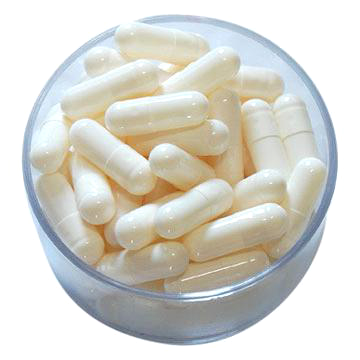Glucosamine safety is a big concern of those with osteoarthritis. What are the glucosamine side effects, and is it safe?
 Human joints struggle to regenerate. Over time, they may experience an age-related breakdown, often in the form of osteoarthritis.
Human joints struggle to regenerate. Over time, they may experience an age-related breakdown, often in the form of osteoarthritis.
According to the Arthritis Foundation, Osteoarthritis affects 27 million Americans, with some estimates placing that number closer to 40 million.
Estimate's show that osteoarthritis costs the economy 126 billion dollars annually according to the 2003 Medical Expenditures Survey, and costs each individual living with arthritis an estimated $5,700.
Controlling joint breakdown is an important part of healthy living. But there are very few medically available ways to control or prevent osteoarthritis.
No effective or safe medicines can rebuild joints, and surgery is prohibitively expensive and can be dangerous.
That's why millions of people depend on glucosamine – an amino sugar that research has shown is effective at both relieving osteoarthritis symptoms and preventing further joint breakdown. But does glucosamine work? And, if so, is it a worthwhile supplement to take for those suffering from osteoarthritis?
Several studies have sought to find whether or not glucosamine is effective at relieving osteoarthritis symptoms. Many studies have found that, indeed, glucosamine works better than a placebo.
For example, research at the University of Belgium in 2001 tested the effects of Glucosamine Sulfate on osteoarthritis patients in a double-blind study and compared those results to that of placebo.
They tested their subjects in two ways. The first was with a subjective survey, in which respondents provided a rating of their current pain and discomfort, immobility, etc. To ensure that the Glucosamine measurements were measuring not only whether or not the individual experienced less pain, but also experienced less joint degeneration, the researchers also used X-Ray tools to measure the size of the joints and whether they experienced any further breakdown over time.
 Glucosamine proved to be effective at reducing joint discomfort and immobility compared to placebo. Most glucosamine users reported little to no change (and some improvement) in their overall osteoarthritis symptoms.
Glucosamine proved to be effective at reducing joint discomfort and immobility compared to placebo. Most glucosamine users reported little to no change (and some improvement) in their overall osteoarthritis symptoms.
They also found that glucosamine did prevent the degeneration of joints via the joint scan measurements.
Several other studies have confirmed these results. Research supports the idea that glucosamine is effective for relieving the long term symptoms associated with osteoarthritis and preventing further degeneration.
Glucosamine is an amino sugar. Immediately upon entering the body, it gets broken down into glycosylated proteins and lipids. Known as "Glycosaminoglycans," these nutrients are a core component of joints and connective tissue.
Researchers have found that by consuming glucosamine, the body creates more of the nutrients that help regenerate and form joints. Thus, in theory, preventing the joints from degenerating further.
Most studies have focused on the major problem areas of those with osteoarthritis – the knees and the hands.
But the body is not very good at differentiating between connective tissue. The body is unlikely to "target" a specific joint. Rather, it sends all of the joints the glucosamine equally, and the joints that require the most support will receive the nutrients they need. So presumably, glucosamine should be effective for all joints in the body, but further research is needed to confirm the accuracy of that belief.
Numerous studies have shown that glucosamine is far more effective than a placebo at improving long term outlook for those living with osteoarthritis.
However, osteoarthritis is a long term degenerative disease, and the conditions and variables involved make it impossible to confirm with certainty that glucosamine works for everyone. According to the National Center for Complementary and Alternative Medicine, roughly 79% of all users of glucosamine will report an improvement in symptoms.
It should be noted that osteoarthritis is a complex disorder. Those that do not report an improvement in symptoms may have experienced far greater degeneration had they not taken the glucosamine supplements.
Furthermore, osteoarthritis is a long term disease. Those that take glucosamine should not expect immediate improvement, but rather a marked decrease in osteoarthritis progression. Most studies have patients taking glucosamine for as many as three years or longer, and those with osteoarthritis may require the supplement for an even greater amount of time – if not indefinitely.
Numerous studies have confirmed that glucosamine is currently the most effective treatment for relieving and preventing the symptom and progression of osteoarthritis. More research is needed to discover why glucosamine is effective for some more than others. Whether it is beneficial for any joint location, early results are very positive in support of glucosamine treatments.

According to several studies, glucosamine is one of the most common supplement types in the United States.
It's used for both prevention and treatment of osteoarthritis, which affects over 37,000,000 men and women, most of whom are over the age of 40. Osteoarthritis is a condition where the joints degenerate over time and cause pain and immobility.
Glucosamine is a type of amino-sugar that becomes glycosaminoglycan. When consumed, it becomes a component in joint cartilage. Thus glucosamine supplements are believed to help rebuild joint cartilage and prevent a further breakdown from reducing the damage and pain caused by osteoarthritis.
Those that have osteoarthritis depend on glucosamine to manage their osteoarthritis symptoms. But many are concerned that there may not be enough glucosamine research to truly believe that the amino sugar is worth their daily intake.
Researchers at the University of Belgium engaged in their glucosamine study in early 2001, to determine if the effects of glucosamine were real, or simply a result of the placebo effect. Their research paper was titled: "Long-term Effects of Glucosamine Sulphate on Osteoarthritis Progression: A Randomised, Placebo-controlled Clinical Trial" and its full text can be found here.
The goal of this study was to help determine if previous glucosamine research was accurate. And to see if those suffering from severe joint discomfort made any improvements.
The hope was that this study of glucosamine would determine if pharmaceutical treatments normally used to treat osteoarthritis were necessary, or if the natural treatment options would be more/as effective.
For any study of glucosamine to be effective, it must be a "double-blind study." A double-blind study means that neither the patient nor the researchers know which patients are on placebo and which patients are on glucosamine.
To keep the researcher blind to the type of medication, the researcher handed out envelopes with numbers on them to the patients with the corresponding numbers. The envelopes were packed by someone other than the researcher, and the researcher was not notified nor had access to information regarding which patients had which numbers.
Researchers used a sample of 212 patients, all of whom were over the age of 50. They decided to target knee osteoarthritis, as this type of arthritis is one of the most common and should apply to other joints.
To be included in the sample, osteoarthritis had to be determined to be the primary cause of knee pain. Rheumatoid arthritis patients were excluded, as would any patients that had other diseases or inflammation that may be causing knee pain.
Overweight patients were also excluded, as the physical demands of obesity on the joint can make it more difficult to determine the effectiveness of glucosamine and may increase injury risk.
Patients were then assigned to two different groups. Assignment to a group was randomized to prevent the inclusion of any biases, as is necessary to ensure the accuracy of the glucosamine research. One hundred six patients received a sugar pill/placebo, under the belief that it was an osteoarthritis treatment.
The other 106 patients received a supplement that contained 1500 mg of glucosamine sulfate. 1500mg is the most common daily dose approved in Europe.
The glucosamine researchers also set parameters for both the placebo and the research group regarding what types of additional joint medicines they were allowed to take in the event of an emergency and tracked this data to avoid any extraneous variables.
The research took place for three years. At the end of the three years, the researchers would view the osteoarthritis measurements.
Within this study of glucosamine, the researchers were looking for a wide range of factors to allow them to easily track changes.
One – and the most important tool for this type of research – was joint space narrowing, which is a common diagnostic tool for osteoarthritis. Because osteoarthritis refers to joint damage, those with a smaller joint space (the space between the bones of a joint) have worse osteoarthritis.
Measuring joint space narrowing would allow them to use an objective measurement system rather than self-reported pain or improvement, which would be too subjective and may not provide an accurate view of the effects of glucosamine.
They also measured the general symptoms of osteoarthritis using the WOMAC index – a self-report questionnaire developed by the Western Ontario and McMaster Universities to measure the severity of joint pain, with the higher the score representing more pain and severity.
Daily diaries, routine lab tests, and other measurements took place to ensure that any other factors that may affect osteoarthritis outcomes were accounted for.
At the end of three years, the data was collected and compared to measure whether or not the glucosamine research yielded any significant differences.
As is common in health research – especially with an aged population – several participants did drop out of the study. However, the researchers compared and contrasted several pieces of demographic data, WOMAC data, and joint narrowing data, and determined that there was no difference between those that dropped out of the placebo group. Those that dropped out of the glucosamine group, nor was there a significant difference in any measurements beyond those related to osteoarthritis in the remaining sample.
 The results were very favorable for glucosamine.
The results were very favorable for glucosamine.
Those taking glucosamine experienced less joint space narrowing than those with placebo.
Those taking glucosamine also experienced an improvement in their symptoms, while those taking a placebo indicated that their symptoms had become worse.
Twice as many patients taking placebo had what the researchers termed a "severe joint narrowing."
Overall, the results of the glucosamine study indicated that glucosamine is effective for most patients in reducing the effects of osteoarthritis and improving symptoms.
No research is perfect, and while the study of glucosamine described above used numerous tools to ensure the reliability of their data, there are potential limitations to this type of research. These include:
- Some patients taking glucosamine did continue to experience a degeneration of their knee joints. The degeneration indicates that while glucosamine does appear to be very effective for improving long term outlook for those with joint pain, it may not be 100% effective for everyone that uses it.
- Researchers in this glucosamine study used a medically approved level and type of glucosamine extract. Most herbal supplement manufacturers are not required to perform significant research on their products. So you must select a company with success in relieving osteoarthritis problems and make sure you know the type of extraction and purification process they use on the glucosamine. Companies may use poor extraction procedures and deliver any amount or type of glucosamine that is not ideal for healthy joints.
- Glucosamine is a long term treatment designed to nourish joints and prevent further breakdown. As a result, it needs to be taken for a significant period. It does not appear that glucosamine should be seen as a short term solution.
It's also important to note that in the scientific world, you should never depend on a single study. One of the reasons that scientists use the term "theory" is because scientists believe it's important to open up the possibility that the results of the study are due to random chance.
However, it strongly appears as though glucosamine is effective for improving the long term outlook of osteoarthritis. Glucosamine research over the last few decades indicates an improved long term outlook of those with osteoarthritis.
Glucosamine is a type of supplement you take daily. That's why it's so important to ensure that you're comfortable with the risk of glucosamine side effects. Glucosamine is generally a very safe supplement, but like any type of dietary supplement, you should always consider the risks before deciding on treatment.
The most common side effect of glucosamine is an adverse allergic reaction to the ingredients. It's not necessarily an allergy to the glucosamine itself; rather, it's an allergy to where the glucosamine comes from.
Glucosamine is extracted primarily from shellfish. Anyone allergic to shellfish or seafood may want to consult a doctor before starting any glucosamine treatment to avoid any allergic reactions. If you experience any of the following symptoms, consult a doctor:
- Trouble Breathing
- Hives
- Mouth/Throat Swelling
These and other symptoms of shellfish allergies often require immediate attention.
 Compared to many other supplement types, as well as modern medicine, the safety of glucosamine is well documented. That said, nearly every type of supplement can have uncommon or rare side effects.
Compared to many other supplement types, as well as modern medicine, the safety of glucosamine is well documented. That said, nearly every type of supplement can have uncommon or rare side effects.
Some possible side effects of glucosamine use include:
- Upset Stomach
- Sensitivity to Light/Sun
- Fatigue
- Skin Discomfort/Itching
- Headache
Some of these side effects may be related to allergies but can occur on their own. These are the most common types of side effects of glucosamine that users experience.
Rare glucosamine side effects are also possible. Some studies have shown that users experience nausea, gas/bloating, heartburn, constipation, diarrhea, and possibly loss of appetite may occur, though these occur very infrequently.
In some studies, a small percentage of users have experienced a temporary increase in heart rate as a result of taking glucosamine supplements, as well as an increase in blood pressure. Those with high blood pressure or heart health issues may want to check with a doctor about glucosamine safety before starting a joint pain/osteoarthritis regimen.
Some studies have indicated some very rare, but potential glucosamine safety risks. However, the data on them is very mixed.
These suggest that in very rare cases, glucosamine may increase bleeding risk in those with bleeding disorders. They are also trying to see if glucosamine has any effect on protein removal via the kidneys, as a few patients reported an increase in protein in the urine. However, the results of this research are inconclusive.
Glucosamine is a widely used supplement, with minimally reported side effects. Even the most common side effects (upset stomach, headache) were reported by very few of those that take glucosamine products.
An allergic reaction to those that are allergic to shellfish is a serious issue. Like all supplements, it's also important that you check reviews on the supplement manufacturers. Because of the lack of oversight by the FDA, many companies develop cheap products with little regard for safety. In these cases, the glucosamine may pick up other nutrients that could be dangerous.
However, based on all currently available research, glucosamine is safe to use regularly, provided you do not have an allergy. If you suffer from osteoarthritis, glucosamine appears to be an intelligent choice.







 Human joints struggle to regenerate. Over time, they may experience an age-related breakdown, often in the form of
Human joints struggle to regenerate. Over time, they may experience an age-related breakdown, often in the form of  Glucosamine proved to be effective at reducing joint discomfort and immobility compared to placebo. Most glucosamine users reported little to no change (and some improvement) in their overall osteoarthritis symptoms.
Glucosamine proved to be effective at reducing joint discomfort and immobility compared to placebo. Most glucosamine users reported little to no change (and some improvement) in their overall osteoarthritis symptoms.
 The results were very favorable for glucosamine.
The results were very favorable for glucosamine. Compared to many other supplement types, as well as modern medicine, the safety of glucosamine is well documented. That said, nearly every type of supplement can have uncommon or rare side effects.
Compared to many other supplement types, as well as modern medicine, the safety of glucosamine is well documented. That said, nearly every type of supplement can have uncommon or rare side effects.